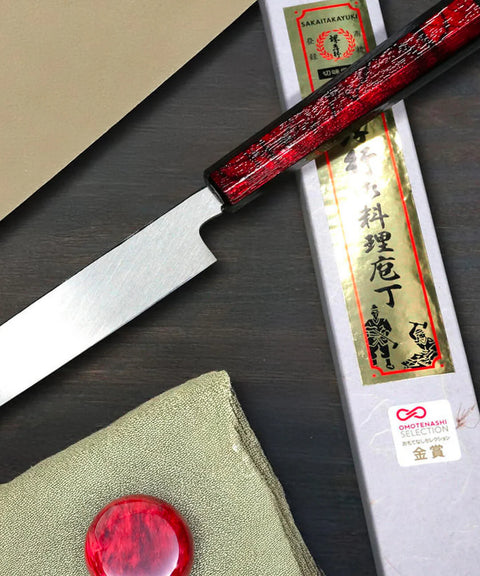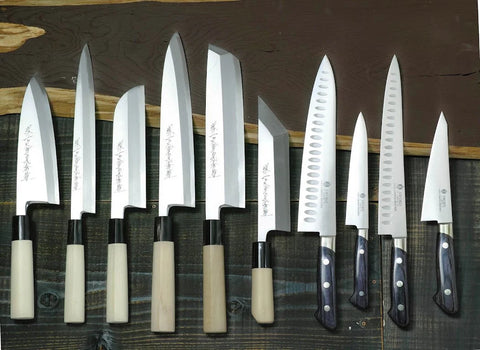
How to Differentiate and Identify an Authentic Japanese Knife: The Ultimate Guide
In recent years, Japanese knives have become a global benchmark for their precision, design, and tradition. But this success has brought with it an avalanche of imitations that don't meet quality standards. If you want to make sure you're investing in a genuine Japanese knife, here's the most comprehensive guide to telling the difference between an authentic knife and a copy.
---- See Petty Hayabusa Knife 15cm VG-10
Why is it important to recognize authenticity?
Buying an original Japanese knife is an investment in quality and durability. Imitations not only lack sharpness and durability, but can also be dangerous and impractical in the kitchen. Knowing how to identify an authentic knife will help you avoid fraud and enjoy a tool that can last a lifetime.
1. Steel: The key to authenticity
The type of steel is the first indicator of quality. Authentic Japanese knives use high-end steels such as:
-
VG10: Stainless steel with excellent edge retention and strength.
-
Aogami (Blue Steel) and Shirogami (White Steel): Carbon steels, famous for their cutting ability and easy sharpening.
-
SG2 (Super Gold 2): Powdered steel, ideal for those seeking maximum performance.
Advice:
If the knife only says "high-quality stainless steel" or doesn't specify the type, be wary. Imitations often hide the true material.

---- See Hayabusa Santoku Knife 18 cm (Ebony)
2. The construction of the blade: Tradition and technology
Traditional Japanese knives are made using advanced techniques:
-
San Mai: Three layers of steel; a hard core protected by two softer layers.
-
Honyaki: Forged from a single piece, reserved for master cutlers.
-
Damascus: Wavy patterns created by layers of steel, providing beauty and strength.
Attention:
Imitations often feature laser-engraved Damascus patterns, not the real thing. Authentic knives also have sharper cutting angles (12–15°) , allowing for more precise and clean cuts.
--- See Hokiyama Bunka Knife 17 cm Aogami
3. The handle: Ergonomics and authenticity
There are two types of mango:
-
Western Mango (Yo-handle): Ergonomics and balance, with metal reinforcements.
-
Japanese handle (Wa-handle): Lightweight, made of fine woods such as ebony or walnut, without metal reinforcements.
Advice:
Copies often use low-quality plastic or wood, with sloppy finishes.
---- See Hayabusa Santoku Knife 18 cm (Bubinga)
4. Origin and brand: The guarantee of quality
An authentic Japanese knife should clearly indicate its origin. Look for:
-
Famous regions: Seki, Sakai, Echizen.
-
Kanji inscriptions: Name of the artisan or manufacturer.
-
Recognized brands: Sakai Takayuki, Masamoto, Shun, Misono, Kanetsugu.
Advice:
If there is no information about the origin or manufacturer, it is probably a fake.
---- See Japanese wabi-sabi thick cotton bag 320g
5. Price: A key indicator
Authentic Japanese knives aren't cheap. Prices typically start at €80-100 and can reach several hundred euros, depending on the material and workmanship.
Attention:
A “Japanese” knife for less than €50 is almost certainly a copy.
Comparison table: Authentic vs. Imitation
| Feature | Authentic knife | Imitation |
|---|---|---|
| Steel | VG10, Aogami, Shirogami, SG2 | Low-quality steel |
| Weight | Light and balanced | Heavy or poorly balanced |
| Price | From €80-100 | Less than €50 |
| Design details | Precision in finishes | Bad endings |
| Origin | Japan, famous regions | Unspecified |
Tips for buying an authentic Japanese knife
-
Buy in specialized stores: Choose reputable suppliers, like Ryo Miura Japan , who work directly with Japanese artisans.
-
Check out the technical specifications: Make sure the steel and manufacturing region are clearly indicated.
-
Avoid suspiciously low prices: A price that is too low is a warning sign.
-
Test the edge: A real knife holds its edge much longer and cuts easily.
-
Check the handle and finishes: The details on the handle and blade are signs of quality.
Expert opinion
Identifying and differentiating an authentic Japanese knife is easy if you know what to look for. At Ryo Miura Japan, we guarantee 100% authentic knives made in Japan , selected from the finest artisan workshops.
Ready to take the plunge and experience the authentic Japanese cuisine in your kitchen?











